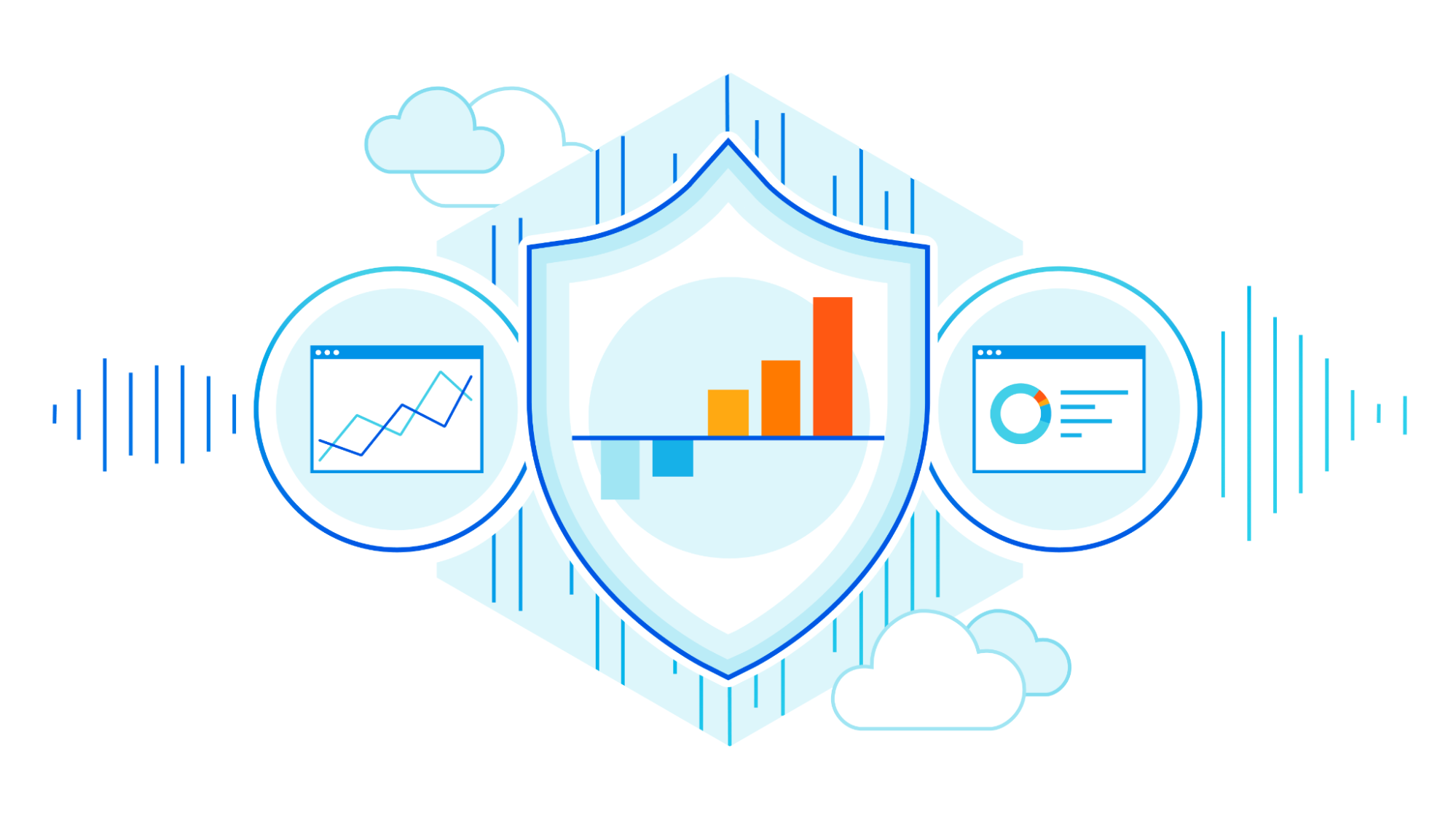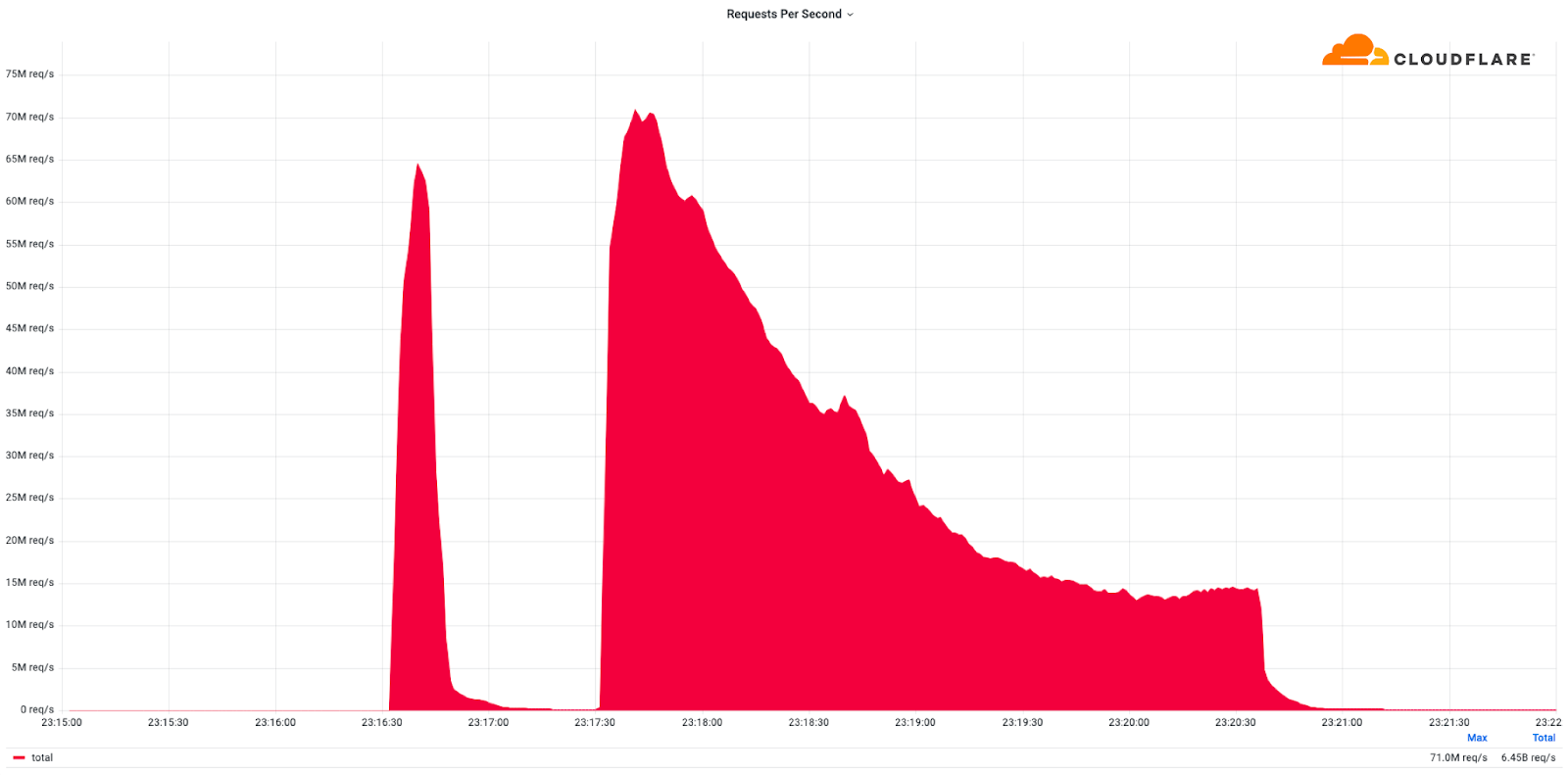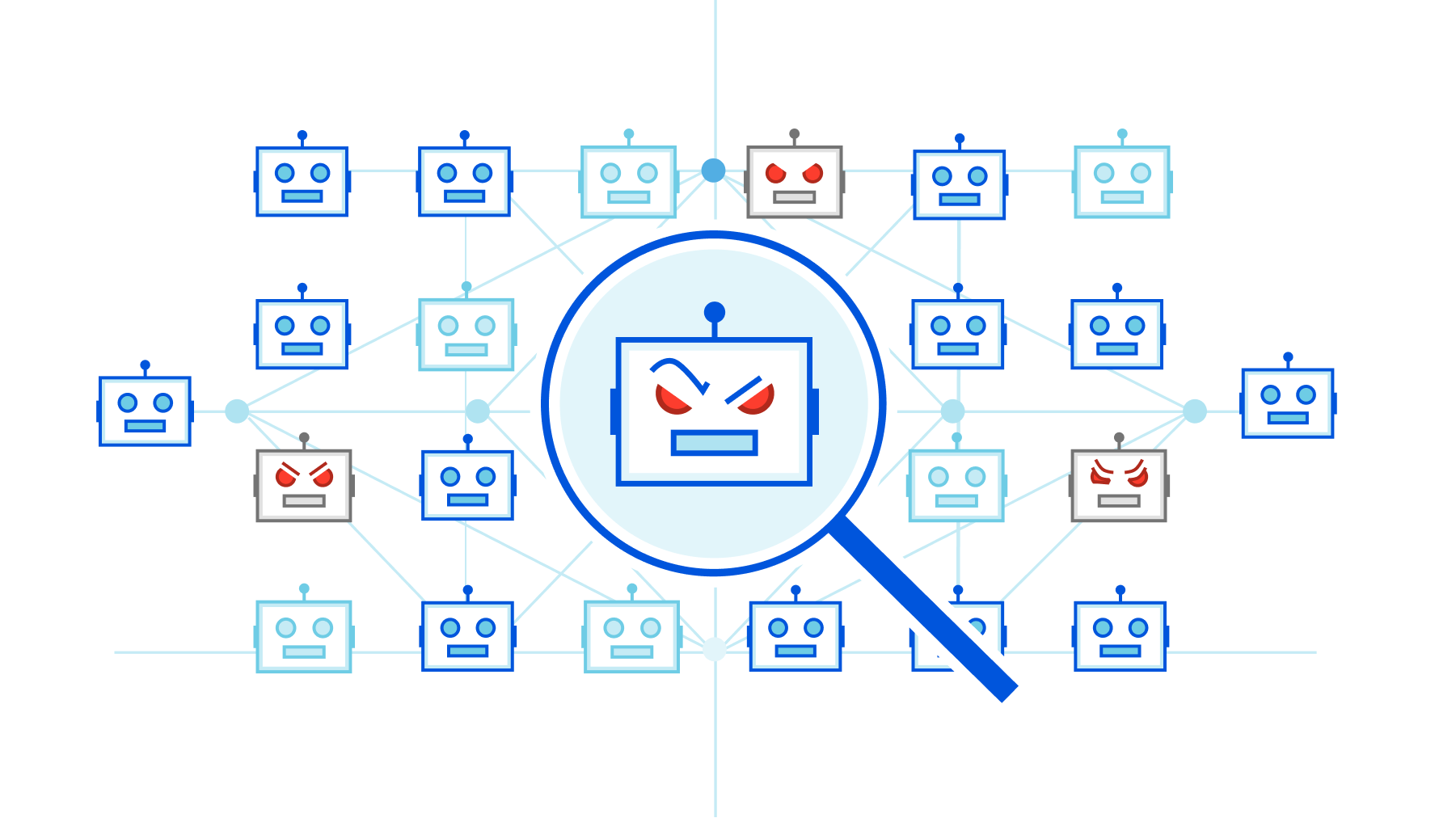Author Archives: Omer Yoachimik
Author Archives: Omer Yoachimik
In mid-May 2025, Cloudflare blocked the largest DDoS attack ever recorded: a staggering 7.3 terabits per second (Tbps). This comes shortly after the publication of our DDoS threat report for 2025 Q1 on April 27, 2025, where we highlighted attacks reaching 6.5 Tbps and 4.8 billion packets per second (pps). The 7.3 Tbps attack is 12% larger than our previous record and 1 Tbps greater than a recent attack reported by cyber security reporter Brian Krebs at KrebsOnSecurity.

New world record: 7.3 Tbps DDoS attack autonomously blocked by Cloudflare
The attack targeted a Cloudflare customer, a hosting provider, that uses Magic Transit to defend their IP network. Hosting providers and critical Internet infrastructure have increasingly become targets of DDoS attacks, as we reported in our latest DDoS threat report. Pictured below is an attack campaign from January and February 2025 that blasted over 13.5 million DDoS attacks against Cloudflare’s infrastructure and hosting providers protected by Cloudflare.

DDoS attack campaign target Cloudflare infrastructure and hosting providers protected by Cloudflare
Let's start with some stats, and then we’ll dive into how our systems detected and mitigated this attack.
Welcome to the 21st edition of the Cloudflare DDoS Threat Report. Published quarterly, this report offers a comprehensive analysis of the evolving threat landscape of Distributed Denial of Service (DDoS) attacks based on data from the Cloudflare network. In this edition, we focus on the first quarter of 2025. To view previous reports, visit www.ddosreport.com.
While this report primarily focuses on 2025 Q1, it also includes late-breaking data from a hyper-volumetric DDoS campaign observed in April 2025, featuring some of the largest attacks ever publicly disclosed. In a historic surge of activity, we blocked the most intense packet rate attack on record, peaking at 4.8 billion packets per second (Bpps), 52% higher than the previous benchmark, and separately defended against a massive 6.5 terabits-per-second (Tbps) flood, matching the highest bandwidth attacks ever reported.
In the first quarter of 2025, Cloudflare blocked 20.5 million DDoS attacks. That represents a 358% year-over-year (YoY) increase and a 198% quarter-over-quarter (QoQ) increase.
Around one third of those, 6.6 million, targeted the Cloudflare network infrastructure directly, as part of an 18-day multi-vector attack campaign.
Furthermore, in the first quarter of 2025, Cloudflare blocked approximately Continue reading
January 27 marks the International Holocaust Remembrance Day — a solemn occasion to honor the memory of the six million Jews who perished in the Holocaust, along with countless others who fell victim to the Nazi regime's campaign of hatred and intolerance. This tragic chapter in human history serves as a stark reminder of the catastrophic consequences of prejudice and extremism.
The United Nations General Assembly designated January 27 — the anniversary of the liberation of Auschwitz-Birkenau — as International Holocaust Remembrance Day. This year, we commemorate the 80th anniversary of the liberation of this infamous extermination camp.
As the world reflects on this dark period, a troubling resurgence of antisemitism underscores the importance of vigilance. This growing hatred has spilled into the digital realm, with cyberattacks increasingly targeting Jewish and Holocaust remembrance and educational websites — spaces dedicated to preserving historical truth and fostering awareness.
For this reason, here at Cloudflare, we began to publish annual reports covering cyberattacks that target these organizations. These cyberattacks include DDoS attacks as well as bot and application attacks. The insights and trends are based on websites protected by Cloudflare. This is our fourth report, and you can view our previous Holocaust Continue reading
Welcome to the 20th edition of the Cloudflare DDoS Threat Report, marking five years since our first report in 2020.
Published quarterly, this report offers a comprehensive analysis of the evolving threat landscape of Distributed Denial of Service (DDoS) attacks based on data from the Cloudflare network. In this edition, we focus on the fourth quarter of 2024 and look back at the year as a whole.
When we published our first report, Cloudflare’s global network capacity was 35 Terabits per second (Tbps). Since then, our network’s capacity has grown by 817% to 321 Tbps. We also significantly expanded our global presence by 65% from 200 cities in the beginning of 2020 to 330 cities by the end of 2024.
Using this massive network, we now serve and protect nearly 20% of all websites and close to 18,000 unique Cloudflare customer IP networks. This extensive infrastructure and customer base uniquely positions us to provide key insights and trends that benefit the wider Internet community.
In 2024, Cloudflare’s autonomous DDoS defense systems blocked around 21.3 million DDoS attacks, representing a 53% increase compared to 2023. On average, in 2024, Cloudflare blocked 4,870 Continue reading
Welcome to the 19th edition of the Cloudflare DDoS Threat Report. Released quarterly, these reports provide an in-depth analysis of the DDoS threat landscape as observed across the Cloudflare network. This edition focuses on the third quarter of 2024.
With a 296 Terabit per second (Tbps) network located in over 330 cities worldwide, Cloudflare is used as a reverse proxy by nearly 20% of all websites. Cloudflare holds a unique vantage point to provide valuable insights and trends to the broader Internet community.
The number of DDoS attacks spiked in the third quarter of 2024. Cloudflare mitigated nearly 6 million DDoS attacks, representing a 49% increase QoQ and 55% increase YoY.
Out of those 6 million, Cloudflare’s autonomous DDoS defense systems detected and mitigated over 200 hyper-volumetric DDoS attacks exceeding rates of 3 terabits per second (Tbps) and 2 billion packets per second (Bpps). The largest attack peaked at 4.2 Tbps and lasted just a minute.
The Banking & Financial Services industry was subjected to the most DDoS attacks. China was the country most targeted by DDoS attacks, and Indonesia was the largest source of DDoS attacks.
To learn more about DDoS attacks and other types Continue reading

Welcome to the 18th edition of the Cloudflare DDoS Threat Report. Released quarterly, these reports provide an in-depth analysis of the DDoS threat landscape as observed across the Cloudflare network. This edition focuses on the second quarter of 2024.
With a 280 terabit per second network located across over 230 cities worldwide, serving 19% of all websites, Cloudflare holds a unique vantage point that enables us to provide valuable insights and trends to the broader Internet community.
View the interactive version of this report on Cloudflare Radar.
Before diving in deeper, let's recap what a DDoS attack is. Short for Distributed Denial of Service, a DDoS attack is a type of cyber attack designed to take down or disrupt Internet services, such as websites or mobile apps, making them unavailable Continue reading

Welcome to the 17th edition of Cloudflare’s DDoS threat report. This edition covers the DDoS threat landscape along with key findings as observed from the Cloudflare network during the first quarter of 2024.
But first, a quick recap. A DDoS attack, short for Distributed Denial of Service attack, is a type of cyber attack that aims to take down or disrupt Internet services such as websites or mobile apps and make them unavailable for users. DDoS attacks are usually done by flooding the victim's server with more traffic than it can handle.
To learn more about DDoS attacks and other types of attacks, visit our Learning Center.
Quick reminder that you can access previous editions of DDoS threat reports on the Cloudflare blog. They are also available on our interactive hub, Cloudflare Radar. On Radar, you can find global Internet traffic, attacks, and technology trends and insights, with drill-down and filtering capabilities, so you can zoom in on specific countries, industries, and networks. There’s also a free API allowing academics, data sleuths, and other web enthusiasts to investigate Internet trends across the globe.
To learn how we prepare this report, refer Continue reading

We're proud to introduce the Advanced DNS Protection system, a robust defense mechanism designed to protect against the most sophisticated DNS-based DDoS attacks. This system is engineered to provide top-tier security, ensuring your digital infrastructure remains resilient in the face of evolving threats.
Our existing systems have been successfully detecting and mitigating ‘simpler’ DDoS attacks against DNS, but they’ve struggled with the more complex ones. The Advanced DNS Protection system is able to bridge that gap by leveraging new techniques that we will showcase in this blog post.
Advanced DNS Protection is currently in beta and available for all Magic Transit customers at no additional cost. Read on to learn more about DNS DDoS attacks, how the new system works, and what new functionality is expected down the road.
Register your interest to learn more about how we can help keep your DNS servers protected, available, and performant.
Distributed Denial of Service (DDoS) attacks are a type of cyber attack that aim to disrupt and take down websites and other online services. When DDoS attacks succeed and websites are taken offline, it can lead to significant revenue loss and damage to Continue reading

Welcome to the third DDoS threat report of 2023. DDoS attacks, or distributed denial-of-service attacks, are a type of cyber attack that aims to disrupt websites (and other types of Internet properties) to make them unavailable for legitimate users by overwhelming them with more traffic than they can handle — similar to a driver stuck in a traffic jam on the way to the grocery store.
We see a lot of DDoS attacks of all types and sizes, and our network is one of the largest in the world spanning more than 300 cities in over 100 countries. Through this network we serve over 64 million HTTP requests per second at peak and about 2.3 billion DNS queries every day. On average, we mitigate 140 billion cyber threats each day. This colossal amount of data gives us a unique vantage point to understand the threat landscape and provide the community access to insightful and actionable DDoS trends.
In recent weeks, we've also observed a surge in DDoS attacks and other cyber attacks against Israeli newspaper and media websites, as well as financial institutions and government websites. Palestinian websites have also seen a significant increase in DDoS attacks. View Continue reading

On October 7, 2023, at 03:30 GMT (06:30 AM local time), Hamas attacked Israeli cities and fired thousands of rockets toward populous locations in southern and central Israel, including Tel Aviv and Jerusalem. Air raid sirens began sounding, instructing civilians to take cover.
Approximately twelve minutes later, Cloudflare systems automatically detected and mitigated DDoS attacks that targeted websites that provide critical information and alerts to civilians on rocket attacks. The initial attack peaked at 100k requests per second (rps) and lasted ten minutes. Forty-five minutes later, a second much larger attack struck and peaked at 1M rps. It lasted six minutes. Additional smaller DDoS attacks continued hitting the websites in the next hours.

Multiple Israeli websites and mobile apps have become targets of various pro-Palestinian hacktivist groups. According to Cybernews, one of those groups, AnonGhost, exploited a vulnerability in a mobile app that alerts Israeli civilians of incoming rockets, “Red Alert: Israel”. The exploit allowed them to intercept requests, expose servers and APIs, and send fake alerts to some app users, including a message that a “nuclear bomb is coming Continue reading


Welcome to the second DDoS threat report of 2023. DDoS attacks, or distributed denial-of-service attacks, are a type of cyber attack that aims to disrupt websites (and other types of Internet properties) to make them unavailable for legitimate users by overwhelming them with more traffic than they can handle — similar to a driver stuck in a traffic jam on the way to the grocery store.
We see a lot of DDoS attacks of all types and sizes and our network is one of the largest in the world spanning more than 300 cities in over 100 countries. Through this network we serve over 63 million HTTP requests per second at peak and over 2 billion DNS queries every day. This colossal amount of data gives us a unique vantage point to provide the community access to insightful DDoS trends.
For our regular readers, you might notice a change in the layout of this report. We used to follow a set pattern to share our insights and trends about DDoS attacks. But with the landscape of DDoS threats changing as DDoS attacks have become more powerful and sophisticated, we felt it's time for a change in how we present Continue reading


Te damos la bienvenida al segundo informe sobre amenazas DDoS de 2023. Los ataques DDoS, o ataques de denegación de servicio distribuido, son un tipo de ciberataque cuyo objetivo es sobrecargar de tráfico sitios web (y otros tipos de propiedades de Internet) para interrumpir el funcionamiento normal y que los usuarios legítimos no puedan acceder a ellos, lo mismo que cuando un conductor está atrapado en un atasco de camino al supermercado.
Observamos muchos ataques DDoS de diferentes tipos y tamaños, y nuestra red es una de las mayores del mundo, ya que abarca más de 300 ciudades en más de 100 países. A través de esta red atendemos más de 63 millones de solicitudes HTTP por segundo durante picos de tráfico y más de 2 billones de consultas de DNS cada día. Esta ingente cantidad de datos nos ofrece una perspectiva privilegiada para dar a conocer a la comunidad tendencias reveladoras sobre los ataques DDoS.
Nuestros lectores habituales quizá noten un cambio en el diseño de este informe. Solíamos seguir un patrón fijo para compartir nuestras percepciones y tendencias sobre los ataques DDoS. Sin embargo, creemos que ha llegado el momento de cambiar la forma de presentar nuestras Continue reading


We’re pleased to introduce Cloudflare’s new and improved Network Analytics dashboard. It’s now available to Magic Transit and Spectrum customers on the Enterprise plan.
The dashboard provides network operators better visibility into traffic behavior, firewall events, and DDoS attacks as observed across Cloudflare’s global network. Some of the dashboard’s data points include:


This dashboard was the outcome of a full refactoring of our network-layer data logging pipeline. The new data pipeline is decentralized and much more flexible than the previous one — making it more resilient, performant, and scalable for when we add new mitigation systems, introduce new sampling points, and roll out new services. A technical deep-dive blog is coming soon, so stay tuned.
In this blog post, we will demonstrate how the dashboard helps network operators:
One of the main responsibilities network operators bare is ensuring the operational stability Continue reading


Welcome to the first DDoS threat report of 2023. DDoS attacks, or distributed denial-of-service attacks, are a type of cyber attack that aim to overwhelm Internet services such as websites with more traffic than they can handle, in order to disrupt them and make them unavailable to legitimate users. In this report, we cover the latest insights and trends about the DDoS attack landscape as we observed across our global network.
Threat actors kicked off 2023 with a bang. The start of the year was characterized by a series of hacktivist campaigns against Western targets including banking, airports, healthcare and universities — mainly by the pro-Russian Telegram-organized groups Killnet and more recently by AnonymousSudan.
While Killnet-led and AnonymousSudan-led cyberattacks stole the spotlight, we haven’t witnessed any novel or exceedingly large attacks by them.
We did see, however, an increase of hyper-volumetric DDoS attacks launched by other threat actors — with the largest one peaking above 71 million requests per second (rps) — exceeding Google’s previous world record of 46M rps by 55%.
Back to Killnet and AnonymousSudan, while no noteworthy attacks were reported, we shouldn't underestimate the potential risks. Unprotected Internet Continue reading


This was a weekend of record-breaking DDoS attacks. Over the weekend, Cloudflare detected and mitigated dozens of hyper-volumetric DDoS attacks. The majority of attacks peaked in the ballpark of 50-70 million requests per second (rps) with the largest exceeding 71 million rps. This is the largest reported HTTP DDoS attack on record, more than 35% higher than the previous reported record of 46M rps in June 2022.
The attacks were HTTP/2-based and targeted websites protected by Cloudflare. They originated from over 30,000 IP addresses. Some of the attacked websites included a popular gaming provider, cryptocurrency companies, hosting providers, and cloud computing platforms. The attacks originated from numerous cloud providers, and we have been working with them to crack down on the botnet.

Over the past year, we’ve seen more attacks originate from cloud computing providers. For this reason, we will be providing service providers that own their own autonomous system a free Botnet threat feed. The feed will provide service providers threat intelligence about their own IP space; attacks originating from within their autonomous system. Service providers that operate their own IP space can now sign up to the Continue reading


Today we mark the International Holocaust Remembrance Day. We commemorate the victims that were robbed of their possessions, stripped of their rights, deported, starved, dehumanized and murdered by the Nazis and their accomplices. During the Holocaust and in the events that led to it, the Nazis exterminated one third of the European Jewish population. Six million Jews, along with countless other members of minority and disability groups, were murdered because the Nazis believed they were inferior.
Seventy eight years later, after the liberation of the infamous Auschwitz death camp, antisemitism still burns with hatred. According to a study performed by the Campaign Against Antisemitism organization on data provided by the UK Home Office, Jews are 500% more likely to be targeted by hate crime than any other faith group per capita.
From Cloudflare’s vantage point we can point to distressing findings as well. In 2021, cyberattacks on Holocaust educational websites doubled year over year. In 2021, one out of every 100 HTTP requests sent to Holocaust educational websites behind Cloudflare was part of an attack. In 2022, the share of those cyber attacks grew again by 49% YoY. Cyberattacks represented 1.6% of all Continue reading


Welcome to our DDoS Threat Report for the fourth and final quarter of 2022. This report includes insights and trends about the DDoS threat landscape - as observed across Cloudflare’s global network.
In the last quarter of the year, as billions around the world celebrated holidays and events such as Thanksgiving, Christmas, Hanukkah, Black Friday, Singles’ Day, and New Year, DDoS attacks persisted and even increased in size, frequency, and sophistication whilst attempting to disrupt our way of life.
Cloudflare’s automated DDoS defenses stood firm and mitigated millions of attacks in the last quarter alone. We’ve taken all of those attacks, aggregated, analyzed, and prepared the bottom lines to help you better understand the threat landscape.
In the last quarter of the year, despite a year-long decline, the amount of HTTP DDoS attack traffic still increased by 79% YoY. While most of these attacks were small, Cloudflare constantly saw terabit-strong attacks, DDoS attacks in the hundreds of millions of packets per second, and HTTP DDoS attacks peaking in the tens of millions of requests per second launched by sophisticated botnets.

This post is also available in Français, Español, Português, 한국어, 简体中文, 繁體中文, and 日本語.

Welcome to our DDoS Threat Report for the third quarter of 2022. This report includes insights and trends about the DDoS threat landscape - as observed across Cloudflare’s global network.
Multi-terabit strong DDoS attacks have become increasingly frequent. In Q3, Cloudflare automatically detected and mitigated multiple attacks that exceeded 1 Tbps. The largest attack was a 2.5 Tbps DDoS attack launched by a Mirai botnet variant, aimed at the Minecraft server, Wynncraft. This is the largest attack we’ve ever seen from the bitrate perspective.
It was a multi-vector attack consisting of UDP and TCP floods. However, Wynncraft, a massively multiplayer online role-playing game Minecraft server where hundreds and thousands of users can play on the same server, didn’t even notice the attack, since Cloudflare filtered it out for them.

Overall this quarter, we've seen:


We’re pleased to introduce Cloudflare’s free Botnet Threat Feed for Service Providers. This includes all types of service providers, ranging from hosting providers to ISPs and cloud compute providers.
This feed will give service providers threat intelligence on their own IP addresses that have participated in HTTP DDoS attacks as observed from the Cloudflare network — allowing them to crack down on abusers, take down botnet nodes, reduce their abuse-driven costs, and ultimately reduce the amount and force of DDoS attacks across the Internet. We’re giving away this feed for free as part of our mission to help build a better Internet.
Service providers that operate their own IP space can now sign up to the early access waiting list.
Cloudflare provides services to millions of customers ranging from small businesses and individual developers to large enterprises, including 29% of Fortune 1000 companies. Today, about 20% of websites rely directly on Cloudflare’s services. This gives us a unique vantage point on tremendous amounts of DDoS attacks that target our customers.
DDoS attacks, by definition, are distributed. They originate from botnets of many sources — in some cases, from hundreds of thousands to millions Continue reading


We’re pleased to introduce Advanced DDoS Alerts. Advanced DDoS Alerts are customizable and provide users the flexibility they need when managing many Internet properties. Users can easily define which alerts they want to receive — for which DDoS attack sizes, protocols and for which Internet properties.
This release includes two types of Advanced DDoS Alerts:
Standard DDoS Alerts are available to customers on all plans, including the Free plan. Advanced DDoS Alerts are part of Cloudflare’s Advanced DDoS service.
Distributed Denial of Service attacks are cyber attacks that aim to take down your Internet properties and make them unavailable for your users. As early as 2017, Cloudflare pioneered the Unmetered DDoS Protection to provide all customers with DDoS protection, without limits, to ensure that their Internet properties remain available. We’re able to provide this level of commitment to our customers thanks to our automated DDoS protection systems. But if the systems operate automatically, why even be Continue reading